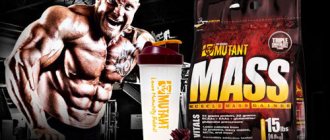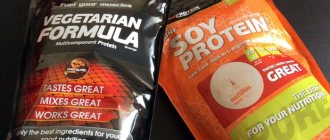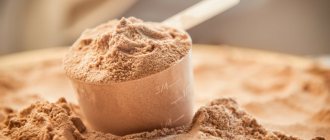Proteins and proteins
Everyone needs proteins, not to mention young athletes. This is the basis of our cells, ligaments, etc. In order to avoid a dangerous lack of protein, doctors advise consuming a gram of protein per kilogram of weight per day. First of all, add meat, dairy products, eggs and seafood to your diet.
The well-known protein, widely used by athletes, is nothing more than protein. The protein is available in powder form; it should be purchased only from reliable manufacturers (mostly foreign). The protein is obtained from the whey remaining after cheese production, without the addition of chemical elements.
The most effective way to use it is a cocktail with the addition of fruits or berries, as well as milk or natural juice, which makes the use more natural and tastier. But usually it makes no sense to feed a child proteins, since strength exercises are limited, and the muscles develop independently. An excess of protein at an early age accelerates puberty and disrupts the functioning of the digestive system.
Proteins
Protein is one of the most popular nutritional supplements (if not the most popular) among bodybuilders. In general, protein is a simple protein, and protein, as you know, is the main building material of the body (it is due to it that muscle tissue is restored and built up). This process consists of the breakdown of protein molecules into amino acids, from which muscle tissue is in turn synthesized.
I think it’s clear that if an athlete wants to gain muscle mass, then he cannot do without a certain amount of this very protein. This is precisely why there are high-protein mixtures (about 70-90% protein content), called proteins in the usual sense for some.
In general, protein enters the body daily from foods such as poultry, fish, meat, eggs, milk, cheese, etc. So why drink any mixtures, you ask? The answer is simple: for stable growth of muscle mass, substances obtained from food are not always enough, so athletes are forced to consume proteins in more concentrated doses, i.e. protein mixtures. And another advantage of these mixtures is that the content of other substances in them, not always useful, (such as fat, carbohydrates, cholesterol, etc.) is minimized. It follows that by consuming protein mixtures we eliminate the intake of unnecessary calories into the body, but at the same time increase the concentration of protein, which is so necessary for muscle growth.
Among other things, there are several types of proteins:
Whey Protein | It is a leader among proteins due to its very high rate of breakdown and rapid activation and enhancement of muscle metabolism. It is quickly digested, due to which amino acids quickly enter the muscles in large quantities for the synthesis of new muscle mass. This type of protein is also rich in BCAA amino acids, which are essential for muscle tissue synthesis and maintenance. Whey protein is assigned the highest coefficient of biological value (shows how much protein from the consumed amount will be absorbed by the body). Methods of obtaining: Whey is a by-product obtained during the production of cottage cheese and cottage cheese. Depending on the extraction technology, whey protein is divided into 3 types (they differ in the level of filtration and percentage of protein): 1. Concentrate The production technology consists of filtering whey through ceramic membranes with micro-holes, through which fat and carbohydrate molecules pass freely, but are retained more large ones are protein. The protein accumulated on this membrane is then collected and exposed to high temperatures to convert the whey protein into a dry powder. But this technology has one “but”: it is technically impossible to obtain holes of the same diameter, which means that with this type of filtration it is impossible to achieve high purity of the product, and a mixed mass remains on the membrane, the protein content of which is about 35-85%. So keep in mind that whey concentrate is not pure and may contain excess fat and lactose. But in whey protein concentrate, the protein fractions remain intact, due to which it fully exhibits its beneficial properties. So: this type of protein is not a leader, but with limited financial resources it is a good option. 2. Isolate The most purified protein, but not the cheapest. Whey protein isolate is produced through ion exchange and extensive filtration. The protein concentration in the final product is about 90-95%. Carbohydrates, fats, etc. are almost completely absent, hence we conclude that this type of protein is suitable for any sports diet. Also, whey protein isolate has a very fast absorption rate, i.e. Helps quickly restore muscles almost immediately after training. 3. Hydrolyzate This type of protein is absorbed even faster than isolate. This rate of absorption is achieved due to the fact that the hydrolyzate is obtained by hydrolysis, during which large protein molecules are cut into separate fragments. Usually this work is assigned to your digestive system, but in this case the body receives a product that is completely ready for absorption. Many experts believe that hydrolyzate is indispensable for use after training, when the body needs to begin recovery work as quickly as possible. But keep in mind that hydrolyzed protein is the most expensive type of protein. |
Egg protein | Before the discovery of whey protein (early 90s), egg protein confidently held the lead among proteins. Egg protein is extracted from whole eggs and is a kind of standard among proteins, because... has a high digestibility rate (biological value of about 100 units) - this means that this type of protein is absorbed almost completely and with minimal losses in the form of breakdown products. Although egg protein is absorbed better than whey, it is not as quickly as its competitor (although this also has a plus - it is able to feed the body with amino acids for a long time). Egg whites also contain no lactose, which causes digestive problems for many athletes. But among the entire range of nutritional supplements, egg protein is a rather rare thing, and most likely the price will not please you. This protein, once the most popular, has given way to whey protein in the market. |
Casein | Casein is a long-lasting complex protein produced from milk using ultrafiltration. It’s worth immediately clarifying the fact that casein is suitable for weight gain only in tandem with fast whey, because the first has less biological value, therefore has a low anabolic effect, but is absorbed over a long period of time (about 7 hours), during which it provides the body with the necessary amino acids. Therefore, whey and casein complement each other very well: the first has a powerful anabolic effect, and the second stretches the process of protein synthesis. This is especially true before bedtime, because... Only casein can provide amino acids throughout the entire sleep process. In addition to its long-lasting effect, casein also significantly suppresses appetite, which is useful for burning fat. To summarize: use casein protein when you need to stretch out the process of protein absorption, thanks to it you can prolong the feeling of fullness, and the muscles will receive the required amount of protein (as mentioned above, this is very important during sleep). They cannot replace whey protein, but their work in two shifts will be very effective. |
Soy protein | This type of protein has a weak anabolic effect and, as a result, is useless for bulking, but, like casein, it is slow and has the property of preventing the breakdown of muscle tissue. The advantages include the absence of lactose, which is a good help for those who are lactose intolerant, and low cost. Otherwise, it is the worst among all types of proteins and has low biological value. Despite active advertising, it has one very unpleasant side effect, according to some researchers: when consuming soy protein, the level of estrogen (female hormone) increases and the level of testosterone (male hormone) decreases; it also negatively affects erectile function. However, in fairness, it is worth noting that there have not been enough global studies to make accurate statements, and the issue of side effects of soy protein is much controversial. |
Is it possible to replace all meals with protein?
Protein and other sports nutrition are only ADDITIONS to the main diet. You should not consume only one protein, at a minimum, for the following reasons.
Firstly, in addition to protein (protein), the body needs other vital nutrients, without which the body’s greatest productivity is impossible.
Secondly, protein (powder) is digested much easier than “regular” food, so if you drink only one protein for a long time, the body will stop producing enzymes that digest other food, because. it minimizes energy expenditure and removes what is not used (just like muscles when you are not using them).
Use protein, preferably only as a supplement, to main meals.
By the way, here is my article about protein shakes at home for a set. There I wrote about many options for very cool cocktails for gaining muscle mass and losing weight. I highly recommend reading it.











